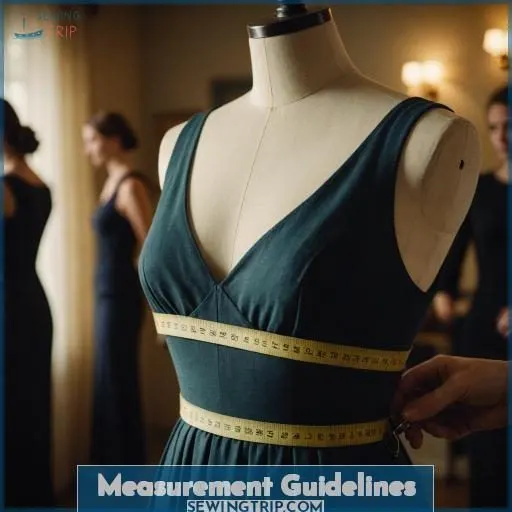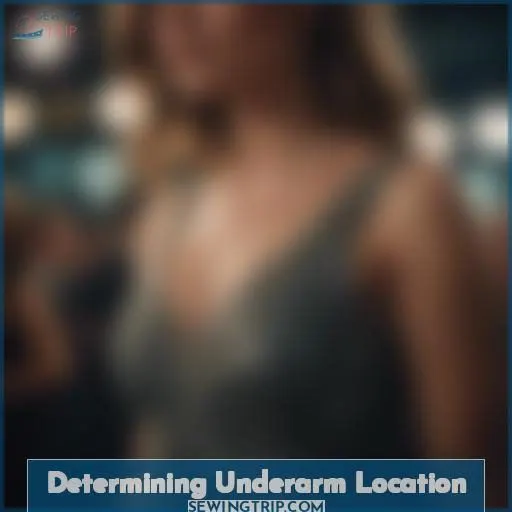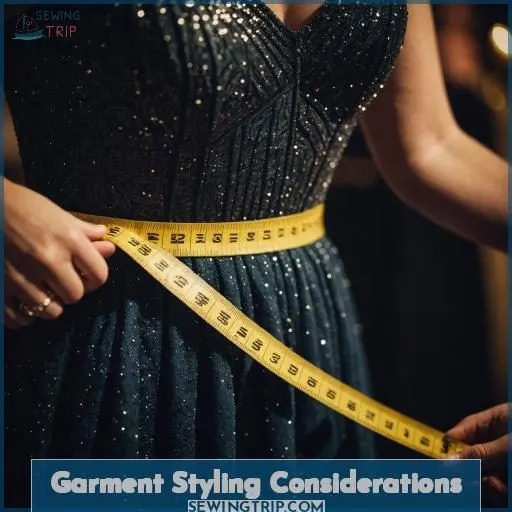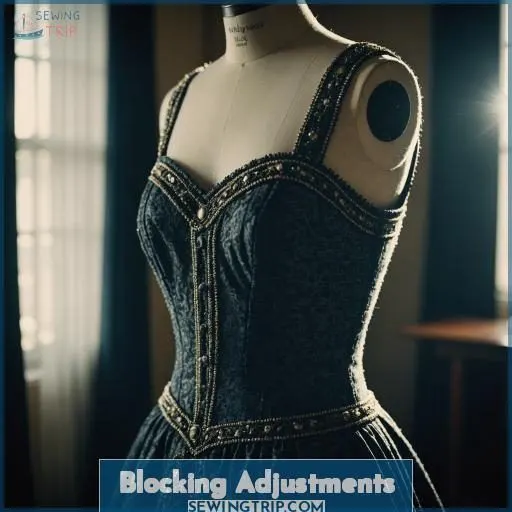This site is supported by our readers. We may earn a commission, at no cost to you, if you purchase through links.
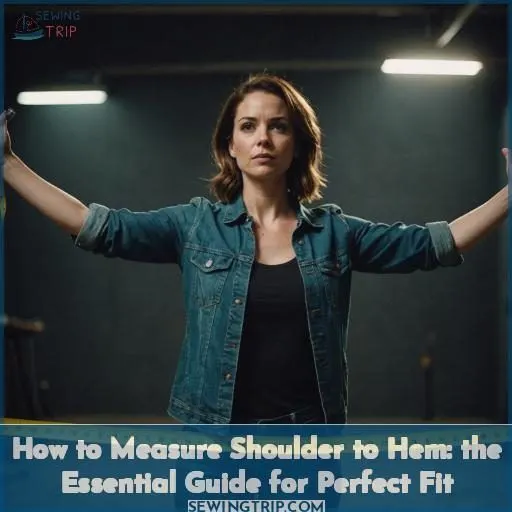 To measure the shoulder to hem length, stand upright and use a flexible measuring tape. Start at the top of your shoulder, where the seam meets your neck, and run the tape down the front of your body to the desired hem length. Make sure the tape is straight and level as you measure.
To measure the shoulder to hem length, stand upright and use a flexible measuring tape. Start at the top of your shoulder, where the seam meets your neck, and run the tape down the front of your body to the desired hem length. Make sure the tape is straight and level as you measure.
This crucial measurement determines the overall garment length and silhouette. Consider your body proportions, preferred styles, and outfit pairings to find the perfect shoulder to hem length for your needs.
Table Of Contents
Key Takeaways
- Stand upright and use a flexible measuring tape to measure shoulder to hem length.
- Consider body proportions, preferred styles, and outfit pairings when determining the ideal shoulder-to-hem length.
- For accurate measurements, follow the provided measurement guidelines, including standing tall and wearing the same undergarments as you would with the final ensemble.
- Use existing garments as a guide for desired overall lengths and modify patterns for shoulder shaping, bodice fit, and finished edge of the shoulder based on extra measurements.
How to Measure Shoulder to Hem?
To measure shoulder to hem, start at the highest point on the shoulder near the neck and measure straight down to the bottom hem of the garment. This method guarantees an accurate length measurement for a perfect fit.
Measurement Guidelines
To guarantee an ideal fit, it’s essential to adhere to the provided measurement instructions. Stand upright, maintain the measuring tape close, and refrain from adjusting your posture – wear the same undergarments that you’ll wear with the garment.
General Measurement Guidelines
When aiming for that perfect fit, think of your measuring tape as your trusty sidekick.
Always stand tall, wearing the undergarments you’d pair with the final ensemble for consistency in measurements.
Forget about sucking in or puffing out; let’s keep it real.
Exploring alternative methods?
Virtual measuring can be a game-changer, but nothing beats the precision of a good old-fashioned tape measure.
Common Measurements
To measure accurately, follow these guidelines:
- Bust: Measure around the fullest part of the bust while wearing a properly fitted bra.
- Waist: Measure around the smallest part of the waist, just above the belly button.
- Hip: Measure around the widest part of the hips and buttocks.
- Waist to Hem: Measure from the waist to the bottom of the hem.
- Shoulder to Waist: Measure from the top of the shoulder to the waist.
Additional measurements include:
- Neck: Measure around the neck, near the base.
- Underbust: Measure right under the bust measurement.
- Waist to Hip: Measure from the waist to the hip, along the side of the body.
- Wrist: Measure around the wrist, above where the arm joins the hand.
- Inseam: Measure from the top of the crotch to the length of the pant.
- Shoulder Width: Measure across the shoulder, from one shoulder point to the other.
For garment length components, consider:
- Shoulder-to-underarm length: Determines underarm location.
- Underarm-to-hem length: Varies based on garment style.
When measuring existing garments, examine them to determine preferred length fits. Different styles have varying lengths, so identify garments with desired overall lengths. Use these existing garment lengths as starting points for new projects.
When styling garments, consider the outfit silhouette and how the garment will be styled. Certain pairings may complement certain lengths, and personal preference determines the most suitable length for different styling options.
For blocking adjustments, wet blocking can lengthen garments, especially superwash yarns. Measure swatch before and after blocking to determine row gauge change. Estimate garment growth based on swatch measurements and adjust knitting length accordingly.
Additional Measurements
To guarantee a perfect fit, it’s vital to take into account extra measurements.
These include neck circumference, underbust circumference, waist to hip length, wrist circumference, and inseam length.
By taking these measurements, you can modify patterns for shoulder shaping, bodice fit, and finished edge of shoulder.
Measurement Assistance
When it pertains to gauging shoulder to hem, various tools and techniques are accessible to guarantee precision. Here are some ways to obtain the measurements correctly:
- Measuring Tools: Acquire a top-notch measuring tape, pliable ruler, and a seam gauge. These implements will aid you in taking exact measurements and marking the correct seam allowances.
- Professional Guidance: If you’re uncertain about your measurements or seek a professional opinion, contemplate consulting a tailor or a pattern scout. They can proffer expert counsel and assist you in obtaining the correct measurements for your garment.
- Measuring Buddies: You can also request a friend to assist you in taking the measurements. They can provide an additional perspective and ensure that the measurements are precise.
- Personal Proclivities: Remember to take your personal preferences and style into account when taking measurements. For instance, if you favor a certain silhouette or garment length, be sure to modify your measurements accordingly.
- Garment Architecture: Be aware of the construction of your garment. For example, a raglan-style garment may have underarms more proximate to the armpit than a drop-shoulder garment, which can impact your shoulder-to-underarm length.
Additional Considerations
To guarantee an ideal fit for your garment, consider these additional factors when measuring:
- Length estimation: Determine how long you desire the garment to be. This can be affected by the style of the garment and your personal preference.
- Fabric choice: Different fabrics may require modifications to the seam allowance. For example, elastic fabrics may need more ease than non-elastic ones.
- Seam allowance: This is the amount of fabric you fold over to create a seam. It can vary depending on the type of fabric and the type of garment.
- Personal preference: Some people prefer a more form-fitting look, while others prefer a looser fit. Consider your personal style and comfort level when making measurements.
Garment Length Components
To measure for a perfectly fitting garment, you’ll need to determine the shoulder-to-underarm length and the underarm-to-hem length. These measurements work together to make sure the right overall length from your shoulder to the bottom hem.
Shoulder-to-underarm Length
To determine the shoulder-to-underarm length, you’ll need to take into account the sleeve length, shoulder seam, bust shaping, armhole depth, and back neckline. This measurement is essential because it affects the overall fit and comfort of your garment. Here’s a step-by-step guide on how to measure shoulder-to-underarm length:
- Sleeve length: Measure from the top of your shoulder to the wrist, considering the desired length for your sleeves.
- Shoulder seam: Measure from the top of your shoulder to the shoulder seam on a garment that fits you well.
- Bust shaping: Think about the fullness of your bust and how it affects the shoulder-to-underarm length.
- Armhole depth: Measure the depth of the armhole on a garment that fits you well.
- Back neckline: Make sure the shoulder seam lines up with your back neckline for a comfortable fit.
Underarm-to-hem Length
Ah, the underarm-to-hem length – the unsung hero of a perfect fit!
This measurement determines how long your sweater, dress, skirt, or pants will be.
Consider your desired silhouette and personal style preferences.
Raglan-style garments may have a shorter underarm-to-hem than drop-shoulder designs.
And don’t forget to account for any changes in row gauge after blocking.
Nail this length, and you’ll be strutting in style, my friend.
Determining Underarm Location
To determine the underarm location, you need to think about the shoulder-to-underarm length.
This length is important because it affects the underarm shape and the overall sleeve style.
Raglan-style garments, for example, have underarms closer to the armpit than drop-shoulder garments.
To ensure the fit is right, you should measure the shoulder-to-underarm length and compare it to the shoulder-to-armpit ratio.
Also, consider the neckline seam, bra strap location, center front, and center back when determining the underarm location.
By understanding these factors, you can achieve a perfect fit for your garments.
Measuring Existing Garments
You likely have garments in your closet that fit you well and reflect your desired lengths. Take a look at those pieces, noting the styles and varying overall lengths that work best for your body and preferences. This examination provides a helpful starting point for determining ideal shoulder-to-hem measurements on future projects.
Examine Garments in Closet to Determine Preferred Length Fits
To determine your ideal length fits, begin by inspecting the clothing already in your wardrobe. These existing garments can serve as a guide for the desired overall lengths for your new projects. Different styles have varying lengths, so it’s vital to identify garments with the desired lengths you favor. Once you’ve identified these garments, use their lengths as starting points for your new projects.
For example, if you have a favorite pair of jeans that fit flawlessly, you can use their length as a reference when measuring for a new pair. Similarly, if you have a dress that you adore the length of, you can use that as a guide when measuring for a new dress. This approach guarantees that your new garments will fit and feel comfortable, as they’ll be based on your personal style preferences and previous experiences.
It’s also important to contemplate how you plan to style your garments. Different outfit silhouettes may influence your preferred garment length. For instance, if you favor a more fitted look, you may want a shorter hemline, while if you prefer a more relaxed look, a longer hemline might be more fitting.
Different Styles Have Varying Lengths
Different styles have varying lengths, so it’s essential to think about the occasion and your personal taste when measuring shoulder to hem. For example, a mini dress might be more appropriate for a casual night out, while a long dress is perfect for a formal event.
Fitted styles can make you look slimmer, while loose styles provide comfort. Above-knee dresses are versatile, and below-knee styles can be more modest.
Crop and tunic styles can add a unique touch to your wardrobe. Always refer to patterns like Cashmerette Concord, Pattern Scout Hana, or Pattern Scout Birdie for guidance.
Identify Garments With Desired Overall Lengths
To identify garments with your desired overall lengths, consider the following steps:
- Examine your existing garments: Look through your closet to determine your preferred length fits for different styles.
- Consider the style: Different styles have varying lengths, so it’s imperative to understand what length suits your body type and personal preference.
- Use existing garment lengths as starting points: If you find a garment that fits your desired overall length, use it as a starting point for new projects.
- Consider styling options: Envision how you’ll style the garment, as this can influence your preferred length.
Garment Styling Considerations
When deciding on the ideal shoulder to hem length, consider how you plan to style the garment. The outfit silhouette and specific pairings can influence what length complements your look best, so choose a length that aligns with your personal preferences.
Outfit Silhouette Influences Preferred Garment Length
Your outfit inspiration plays a significant role in determining your preferred garment length. The fabric drape and your personal style can influence how long or short you want your garment to be. Consider your body proportions and the garment’s functionality when making your choice. Remember, the perfect fit is subjective and depends on your unique style preferences.
Certain Pairings May Complement Certain Lengths
Certain pairings can complement certain lengths, enhancing the overall look of your outfit. For instance, a deep neckline can elongate your neck, while a high neckline can balance out a fuller figure.
The fabric of your garment also plays a role; lightweight fabrics can make you appear taller, while heavier fabrics can add bulk.
Accessories, too, can influence the overall look; a long necklace can elongate your neck, while a belt can define your waist.
Consider your body shape and personal style when deciding on the perfect length for your garment.
Personal Preference Determines Optimal Length for Different Styling Options
Your personal style, body type, and the occasion are essential elements in identifying the best length for your garments. Think about the fabric flow and style trends when selecting the length that works best for you. Keep in mind, the most important thing is what makes you feel confident and comfortable.
Blocking Adjustments
Wet blocking is a great way to lengthen your handmade garments, especially if you’re using superwash yarns. Before you start, be sure to measure your swatch carefully so you can estimate how much your finished piece will grow during blocking.
Wet Blocking Can Lengthen Garments, Especially Superwash Yarns
As you move from styling to sizing, keep in mind that wet blocking can be a transformative experience. Superwash yarns are known for their tendency to stretch, so making adjustments after blocking is essential to avoid unintended yarn expansion. Here’s a simple checklist:
- Examine swatch measurements before and after wet blocking.
- Consider the elasticity of superwash yarns.
- Forecast changes to prevent your garment from becoming loose-fitting.
Estimate Garment Growth Based on Swatch Measurements
To assess the garment expansion based on swatch measurements, you need to factor in several elements such as yarn elasticity, blocking parameters, stitch density, and yarn thickness. Here’s a simple 2×4 table to help you grasp the process:
| Element | Description |
|---|---|
| Yarn Elasticity | The extent of stretch the yarn possesses before it breaks. |
| Blocking Parameters | The method and temperature employed for blocking. |
| Stitch Density | The number of stitches per inch in your swatch. |
| Yarn Thickness | The width of the yarn utilized in your project. |
To assess the garment expansion, follow these steps:
- Measure the stitch density of your swatch.
- Ascertain the yarn elasticity by stretching a sample of the yarn and measuring the change in length.
- Block the swatch according to your chosen blocking parameters (e.g., steam, soak, or pin).
- Measure the stitch density of the blocked swatch.
- Compare the stitch density before and after blocking to estimate the potential expansion in your garment.
Frequently Asked Questions (FAQs)
How do I measure shoulder slope?
Hold your arms at your sides with palms facing forward. Have a friend trace the slope from your high shoulder point down to your armpit. This measured angle reveals the shoulder slope.
Can I use a tape measure to determine shoulder slope?
You can certainly use a tape measure to determine shoulder slope. Just run the tape from the base of your neck, over the top of your shoulder, and down to your arm. That’ll give you the shoulder slope measurement.
How does shoulder slope affect garment length?
Your shoulder slope directly impacts the length and fit of your garment. A steeper slope means less fabric over the shoulders, affecting the overall garment drop. Measure carefully to nail that perfect shoulder-to-hem length!
What is the difference between shoulder slope and shoulder width?
Wondering about the difference between shoulder slope and shoulder width? The slope refers to the angle of your shoulders, while the width is simply the distance across from one edge to the other. Clear as mud, right?
Can I adjust shoulder slope for a better fit in garments?
You can adjust the shoulder slope to achieve a better, more flattering fit. By modifying this key measurement, you’ll create a stylish look that suits your unique shape. Get ready to enhance your fashion sense.
Conclusion
Crafting the perfect fit is a delicate dance, where every inch counts. By mastering the art of measuring shoulder to hem, you’ll gain access to garments that hug your curves and elevate your style.
Whether you’re sewing, knitting, or simply shopping, this essential guide will empower you to measure with confidence, ensuring your clothes accentuate your best features.
So, embrace the power of the tape measure and discover the joy of finding that elusive shoulder to hem that was meant for you.

